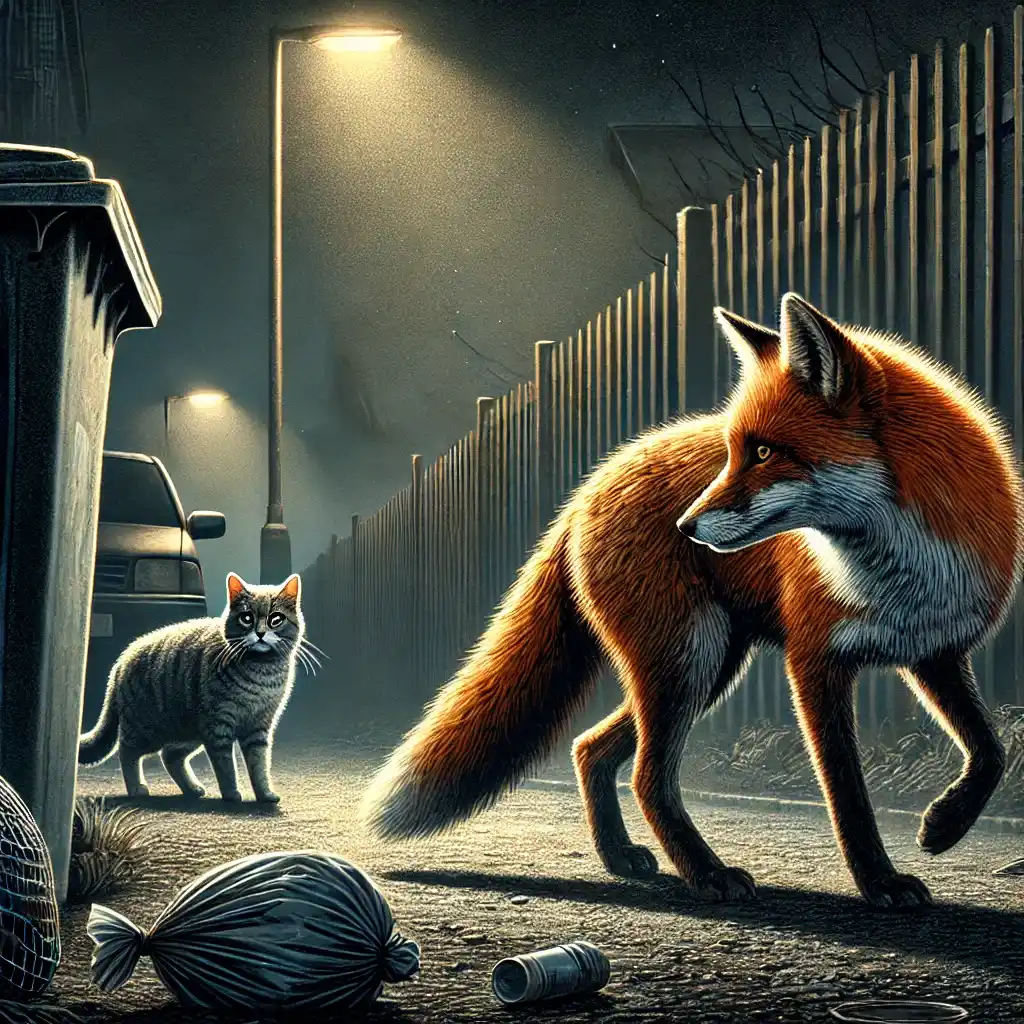Introduction:
1;The Unlikely Predator
The image of a fox eating a cat is an unsettling one for many. Typically, cats are seen as sleek, agile creatures capable of defending themselves against smaller predators. Foxes, on the other hand, are often considered elusive, scavenging animals that keep to their own territories. The idea of a fox hunting and eating a domestic cat challenges not only our understanding of predator-prey relationships but also the dynamics between wildlife and urban environments.
This behavior is shocking because foxes, known for their scavenger habits, don’t often engage in aggressive predation against larger animals like cats. However, this rare event is not entirely impossible. Foxes, like any other predator, must rely on what is available in their environment to survive. While cats might not be at the top of a fox’s food chain, under certain circumstances, a fox might target a cat.

Understanding why and how this happens requires an in-depth look at the fox’s natural behavior, their feeding patterns, and the circumstances that might push them to attack a cat. Additionally, it’s crucial to understand the impact of this behavior on both the fox and the local ecosystem, as well as how pet owners can take steps to protect their cats.
2;Foxes as Predators: Their Natural Diet
What Do Foxes Typically Eat?
Foxes are omnivores, which means they consume a wide variety of foods, both animal and plant-based. In the wild, their diet mainly consists of small mammals like rabbits, rodents, and birds. Foxes also hunt insects, berries, and fruits, depending on the season and the availability of food. In urban areas, foxes often scavenge through trash, looking for scraps of food left behind by humans. This adaptability makes them highly resilient to various environments.
The dietary habits of foxes are influenced by their environment. In rural settings, where natural prey is abundant, foxes focus on hunting small mammals and birds. In urban areas, however, they may rely more on scavenging human food waste, making them a common sight in cities. While they primarily target small prey, foxes are opportunistic feeders, meaning they will take advantage of available resources—whether that’s a mouse, a bird, or, in some rare cases, a domestic cat.

Foxes have a keen sense of hearing, sight, and smell, all of which help them locate their prey. When hunting, they rely on their sharp senses to detect the movement of small animals, making them skilled hunters. However, when food is scarce, foxes might turn to more unusual prey, such as cats, especially if the cat is small, weak, or vulnerable.
Are Foxes Known to Hunt Cats?
Foxes are not typically known to hunt cats, and in most cases, they prefer smaller, easier prey. However, in certain circumstances, foxes have been known to attack and even eat cats. This behavior is rare, but it can occur under specific conditions, such as during food shortages or when a fox feels threatened by a cat.
Foxes are generally more likely to hunt smaller animals that pose less of a risk to them. In fact, most foxes avoid large animals, including adult cats, because of the potential danger. Cats are skilled hunters themselves and can be formidable opponents when cornered. However, foxes are opportunistic animals, meaning they will take advantage of an easy meal if the situation presents itself. If a fox comes across an unguarded, small, or sick cat, it may decide to attack.
Foxes tend to be cautious when approaching larger animals, so the chances of a fox eating a healthy adult cat are low. Nonetheless, outdoor cats that roam alone in fox territories may be at greater risk, particularly if they are sick, injured, or distracted.
3;Why Would a Fox Eat a Cat?
Hunger and Survival Instincts
The primary reason a fox might eat a cat is hunger. Foxes are opportunistic feeders, meaning they will not hesitate to take advantage of whatever prey is available to them. While foxes primarily hunt small mammals and birds, they will not pass up an easy meal. In situations where their regular food sources are scarce, foxes may be forced to target larger animals, such as cats.
This survival instinct is not unique to foxes. Many predators, including big cats and birds of prey, will expand their range and prey on larger animals when food is scarce. Foxes, with their adaptive behavior, can switch their diet depending on what is available, making them highly versatile. This behavior is vital for their survival in the wild, but it can also lead to surprising predatory acts, such as a fox eating a cat.
In regions where fox populations are high and food resources are limited, foxes may struggle to find their usual prey. This can lead to desperate hunting behaviors, where a fox will hunt animals outside its typical diet, such as cats. Furthermore, urbanization has increased the competition for food, as foxes and other wildlife are forced to interact with human habitats more often. This increased proximity between foxes and domestic cats may make such rare predatory events more likely.

Territorial Behavior and Aggression
Foxes are highly territorial animals, and their behavior can become aggressive when defending their territory. Foxes are known to mark their territory with scent glands, and they can become very protective of the area they consider their own. If a cat enters a fox’s territory, especially during mating season or in times of food scarcity, the fox may perceive the cat as a competitor or threat.
In some cases, foxes might attack a cat to drive it away from their territory. This is especially true for male foxes during mating season, when their aggression and territorial instincts are heightened. In this context, the fox is not necessarily hunting for food but is instead trying to eliminate potential rivals. If the cat does not back off or if it challenges the fox, the confrontation may escalate into a violent encounter, with the fox ultimately attacking and eating the cat.
Environmental Factors Influencing Predation
The environment plays a significant role in shaping the behavior of foxes. Foxes thrive in rural, wooded, and suburban areas where food is more abundant, and they can live without human disturbance. However, as urbanization increases, foxes are being forced into closer proximity with human populations. In cities, foxes may find food more easily through scavenging, but they may also face increased competition for resources. This can push them to take risks, such as attacking larger prey, including cats.
In times of extreme weather conditions, such as harsh winters or droughts, foxes may find it difficult to locate their usual food sources. This can result in foxes venturing into urban environments or expanding their hunting territories to include areas where cats are more commonly found. This explains why certain foxes, particularly those in urban or suburban areas, might target cats more often than their rural counterparts.
4;Is It Common for Foxes to Eat Cats?
Frequency of Fox Eating Cat Incidents
While it is not common for foxes to eat cats, such incidents do occur from time to time. Foxes generally prefer small mammals and birds, which are easier to catch and less dangerous. However, in rare cases, a fox might target a cat, especially if the cat is small, sick, or vulnerable. The frequency of these events varies depending on the location, the local fox population, and the availability of other food sources.
In urban areas, where foxes live in closer proximity to humans, incidents of foxes attacking cats are more likely. However, even in these areas, foxes do not regularly hunt cats. Instead, they tend to scavenge human food and hunt smaller animals, such as rats, mice, and birds. The majority of foxes will avoid larger animals, including healthy adult cats, unless they are desperate for food.

5;The Role of Foxes in the Ecosystem
Foxes as Part of the Food Chain
Foxes play an essential role in maintaining the balance of their ecosystems. As natural predators, they play a vital role in regulating the numbers of small mammals, birds, and insects.. By reducing the numbers of prey species, foxes help prevent overgrazing of plants and the spread of diseases. Foxes also help regulate the populations of rodents, which are carriers of diseases like Lyme disease and hantavirus.
Without foxes, these prey populations could grow unchecked, leading to an imbalance in the ecosystem. Foxes are particularly important in forested and rural areas, where they help control the numbers of rodents and other small mammals that could otherwise damage crops or contribute to the spread of disease.
While foxes do pose a risk to domestic pets, their overall impact on the ecosystem is largely beneficial. Foxes contribute to the health of the environment by maintaining the delicate balance of predator and prey species, ensuring biodiversity remains intact.
6;How to Protect Cats from Foxes
Preventative Measures for Pet Owners
To minimize the risk of a fox attacking your cat, there are several steps you can take to protect your pet. One of the most effective ways to keep your cat safe is to keep them indoors, especially at night when foxes are most active. Indoor cats are much less likely to encounter foxes and other predators.
For those who prefer to allow their cats outdoor access, installing a secure outdoor enclosure is a great option. These enclosures provide a safe space for your cat to enjoy fresh air and exercise without being exposed to potential predators. The enclosure should be constructed with sturdy materials and should be tall enough to prevent a fox from entering.

Understanding the Fox’s Hunting Habits
To protect your cat from foxes, it’s important to understand the hunting habits of foxes. Foxes are most active during dawn and dusk, so it is essential to keep your cat indoors during these times. When foxes hunt, they rely on their sharp senses of hearing and smell, so it’s important to ensure that your cat is not in an area where a fox can easily detect them.
7;FAQs
1. Why might a fox eat a cat?
A fox might eat a cat if it is hungry and food sources are scarce. Foxes are opportunistic feeders and may target larger prey like cats if smaller, easier options aren’t available. Territorial aggression and environmental factors, such as food shortages or urbanization, can also drive this behavior.
2. How common is it for foxes to eat cats?
Foxes rarely eat cats. They usually prefer smaller prey like rodents and birds. However, incidents do occur, especially in urban areas where foxes and domestic cats overlap. The frequency depends on factors like fox population and available food sources.
3. What do foxes typically eat?
Foxes are omnivores, eating a mix of animals and plants. They feed on a diverse diet consisting of small mammals, birds, insects, and various fruits.. In urban settings, they may scavenge human food waste. Foxes are opportunistic and will adapt their diet based on what’s available.
4. How do foxes interact with cats?
Foxes tend to avoid adult cats because they pose a threat. However, if a cat is small, sick, or vulnerable, a fox might see it as an easy meal. Foxes may also become aggressive towards cats in territorial disputes, especially during mating season.
5. What can pet owners do to protect cats from foxes?
Pet owners can protect cats by keeping them indoors, particularly at night when foxes are most active. For outdoor access, secure cat enclosures can provide safety. Understanding fox hunting habits and supervising outdoor time can further minimize risks.
8;Conclusion
While the idea of a fox eating a cat is unsettling, it is a rare occurrence that typically happens under specific circumstances. Foxes, as opportunistic feeders, usually prefer smaller prey and tend to avoid larger animals like cats. However, in times of scarcity or territorial conflict, a fox may attack a vulnerable cat. Understanding the reasons behind this behavior highlights the adaptability and survival instincts of foxes. For pet owners, taking precautions such as keeping cats indoors or securing outdoor spaces can minimize risks. Ultimately, foxes play an important role in the ecosystem, and while their interactions with domestic animals should be carefully managed, it is essential to appreciate their role in nature.
